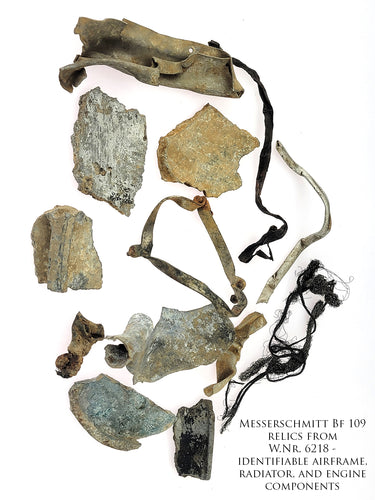This Fine Art Print by Artist Craig Tinder depicts 27 November 1940 engagement between Luftwaffe Bf 109s of JG 51 and RAF Spitfires from the 41st and 74th Squadrons. This Limited Edition Canvas Print includes an actual fragment from Messerschmitt Bf 109 E-4 "Brown 2" W.Nr. 6218.
Details About the RELIC:
This relic fragment is from Messerschmitt Bf 109 E-4, W.Nr. 6218 - known as "Brown 2" piloted by Gefreiter Joachim Hergesell of 3./JG 51. The aircraft took multiple hits on 27 November 1940 and crashed at around 16.00 hrs. Near Iden Green. Much of the airframe remained buried until 1978, when excavation began by the Brenzett Aeronautical Museum. Identifiable components from the airframe, Daimler Benz 601 engine block, radiator, and wiring. From the Brenzett Aeronautical Museum collection.
 Messerschmitt Bf 109 E-4, Daimler Benz 601 engine block, radiator, wiring fragments
Messerschmitt Bf 109 E-4, Daimler Benz 601 engine block, radiator, wiring fragments
 Messerschmitt Bf 109 E-4 W.Nr. 6218 fragments
Messerschmitt Bf 109 E-4 W.Nr. 6218 fragments
The Story Behind the Print:
27 November 1940 - Just weeks after the final major air raids of the Battle of Britain, Germany’s Luftwaffe resumed their "Freie Jagd" (Free Hunt) missions over southern England. These fighter sweeps, which allowed German pilots to engage Allied aircraft without the need to protect bombers, were an attempt to reassert control over the skies. On this clear autumn day, at approximately 15:45 hours, Spitfires from the 41st and 74th Squadrons of the Royal Air Force scrambled to intercept the incoming German fighters.
Among the Luftwaffe pilots that day was Gefreiter Joachim Hergesell of 3./JG 51, flying a Messerschmitt Bf 109 E-4, call sign "Brown 2". As the dogfight escalated in intensity, Hergesell’s aircraft was targeted by an RAF Spitfire. After several minutes of combat, his Messerschmitt sustained a critical hit, leaving him with no choice but to make an emergency landing. Hergesell brought his crippled Bf 109 down at Sarnden Farm near Iden Green, Benenden, Kent. He survived the forced landing and was taken as a prisoner of war by British forces.
 Messerschmitt Bf 109 E-4 of JG 51 - now at RAFM Hendon
Messerschmitt Bf 109 E-4 of JG 51 - now at RAFM Hendon
This incident occurred during the waning months of the Battle of Britain, a time when the Luftwaffe began to reduce its activity over the UK in favor of shifting resources to other fronts. In the weeks following Hergesell’s crash, the frequency of such engagements declined as the Luftwaffe began repositioning its forces for the upcoming invasion of the Soviet Union in Operation Barbarossa. This shift marked a turning point in the aerial battles over England, with the RAF solidifying its control of British skies and the Luftwaffe's attention turning eastward.
Learn more about The Distinction Between the Bf 109 and the Me 109, Click Here
To purchase or see similar items, visit here.
Commissioned by Museums, Treasured by Collectors





Share:
Breaking Barrers, the story behind "The Bone"
Airborne Workhorse, the story behind "The Herky Bird"